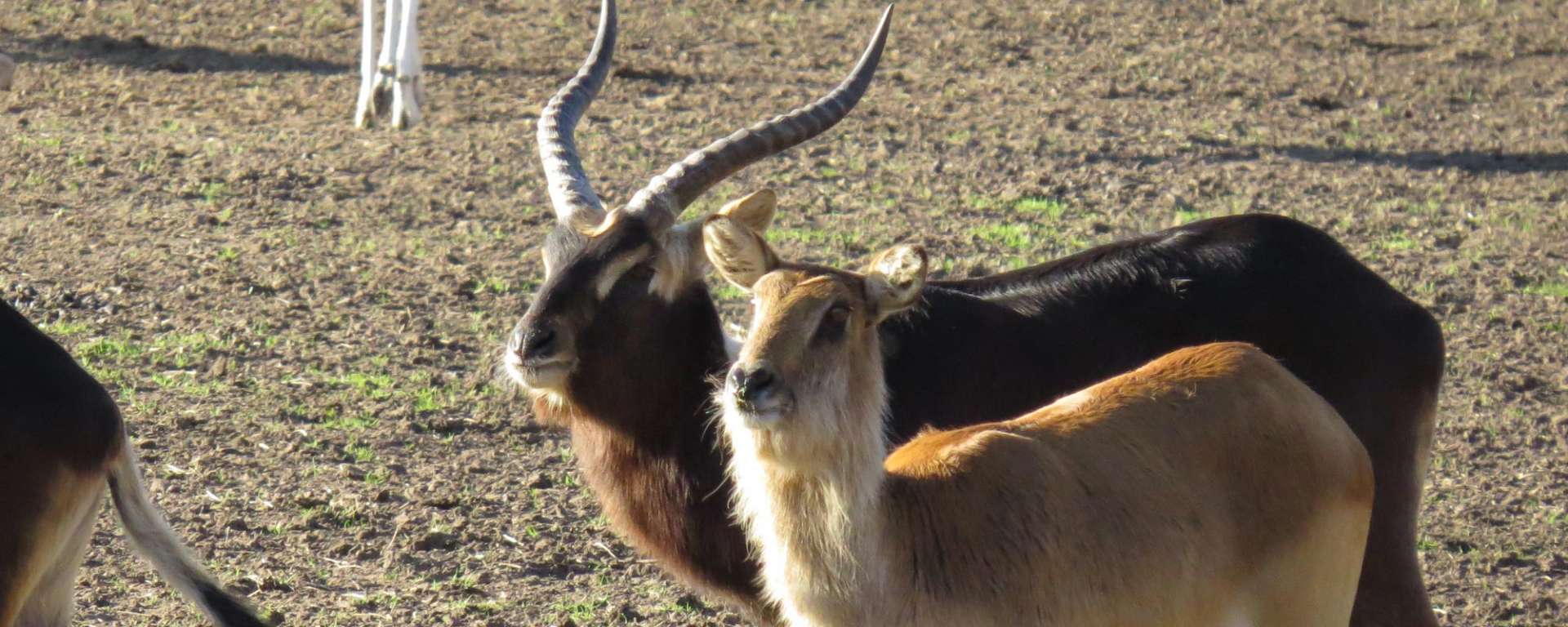Safari Spotlight: The Nile Lechwe
Posted in: Safari Spotlight
Tags: Nile lechwe, sexual dimorphism
Have you heard the term sexual dimorphism? Don’t worry if you haven’t. Like most fancy science words, it’s a simple idea hidden in a confusing term. Basically, if a species is sexually dimorphic, the boys and girls look different. Human beings are sexually dimorphic. Differences in body shape, how much hair we have and where we grow it, how deep our voices are; these are all pretty good hints when sexing a human.
At Safari West, our Nile lechwe antelope are a master class in sexual dimorphism. Our herd of Nile lechwe is visible from the tour boarding area as they stroll among the giraffes and dama gazelles near the tent camp. Our male lechwe looks so strikingly different from the females that many people mistake them for two separate species.
When they’re young, male and female Nile lechwe look much the same. They are a golden-tan in color. Their coats are shaggy and greasy looking. As a group, the lechwe usually looks like they could use a shower. As the females age, they grow into larger versions of their childhood forms; remaining hornless and tan. As the boys grow up, however, they undergo a striking change. As they age, young males change color completely. Beginning when they reach a year or so in age, they’ll darken. When they’re mostly grown, they’ll be almost completely black with a little toupee and cape between their shoulder-blades that retains the youthful brown shade. Fully mature male Nile lechwe look even more striking as that tan colored patch turns to a brilliant white.
Another obvious feature that separates a male lechwe from the females is his enormous set of horns. They are lyre-shaped, meaning they curve in a gentle S-shape rather than sprouting straight out from his head. Heavily ridged at the base where they meet his skull, these horns actually give the Nile lechwe its Latin name; Kobus megaceros or Kobus big-horn (Seems a little messed up to give them a name that only applies to the boys though doesn’t it?).
The dark coat of the male lechwes makes them really easy to spot in open terrain and leads some guests to wonder how they survive in the wild. The answer to that question has a lot to do with the Nile lechwes’ habitat. They are restricted to a small area in southern Sudan and Ethiopia; a mostly inaccessible swamp called the Sudd. In the wet season, they range across grasslands where the water stands 4 to 16 inches deep and then retreat to the true swamps when the weather turns dry. Nile lechwes spend almost their entire lives in this watery world and very few predators choose to follow them into the muck. They are tempting prey for lions, leopards, and wild dogs but luckily, it’s difficult to sneak up on an animal when you’re wading through knee-high water (of course crocodiles don’t have the same troubles).
I mentioned earlier that our lechwe looks a bit greasy. They do, and yes, some people have accused them of looking as though they need a shower. In truth, that oily coat is quite important to a lechwe. Like a duck, a Nile lechwe needs to be able to keep a barrier between itself and the water and its oily coat accomplishes that job beautifully.
Water comes into play in other areas of lechwe life as well. They are a lekking species. This means that rather than having a male who controls a large patch of territory, the boys squabble over little plots of land called leks when they’re in the mood to start a family. First, they’ll fight with the other males over turf. These fights don’t usually last too long as often times, once they’ve locked horns, they wind up pushing one another’s faces underwater.
Once a dominant male has claimed his lek, he’ll occasionally allow in a satellite male to help him police the territory. This other guy is usually younger and smaller and is allowed in to help the dominant male defend his territory. What the little guy gets out of the deal is access to the best food resources. This will make him healthier than the other bachelors and increase his chances of eventually holding territory of his own. The trade-off is that he’s not allowed to mate with any of the females in the lek. Of course, the landlord can’t keep an eye on the satellite male all the time…
Whether dominant or sneaky satellite, once a male has suitably impressed one of the ladies, they will mate. This is often preceded by a very interesting courtship behavior. The male will duck his head between his forelegs and urinate all over his face and throat. Then, shaggy beard dripping with urine, he’ll rub his head on the female’s rump, smearing his eau-de-lechwe on her. The reasons for this behavior are somewhat unclear as of yet, but apparently, the female lechwes view it as a very gentlemanly and chivalrous thing to do. Don’t get any ideas fellas, no human woman wants this for Valentine’s Day.
If you’re interested in seeing these beautiful and bizarre antelope for yourselves, our herd (featuring two brand new babies, by the way) is on display every day here at Safari West.

